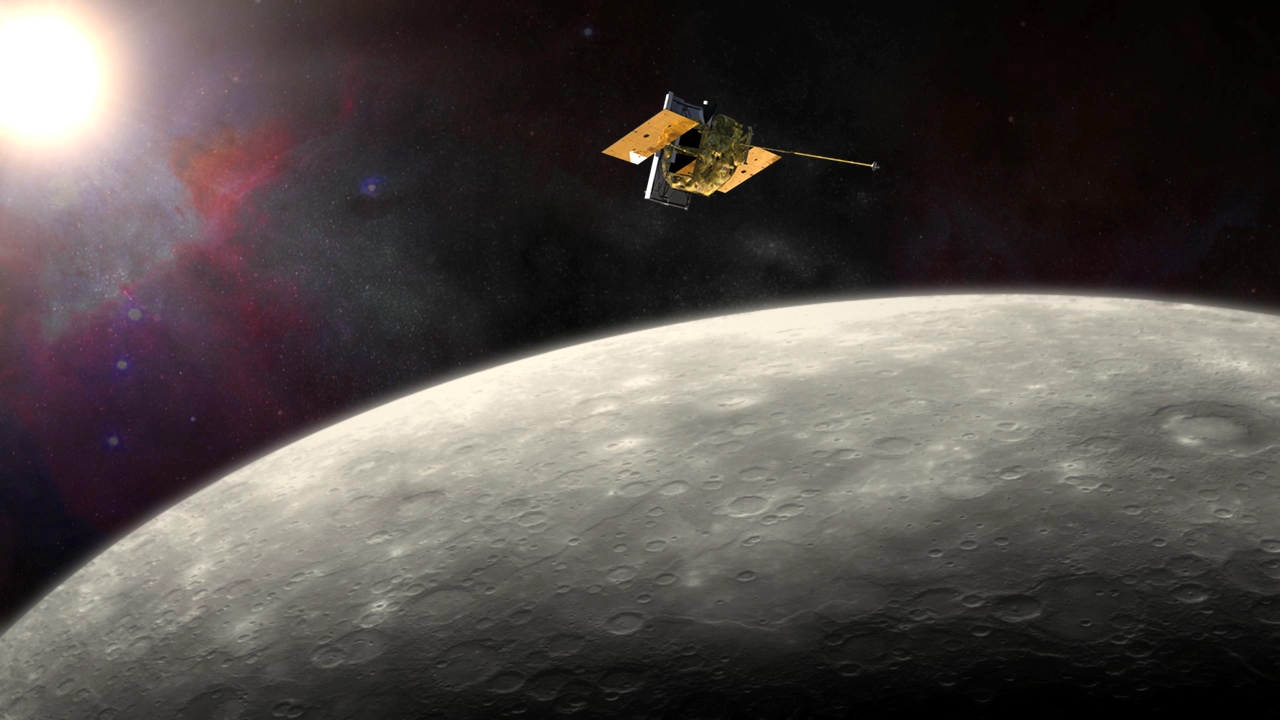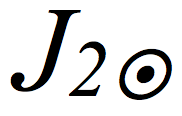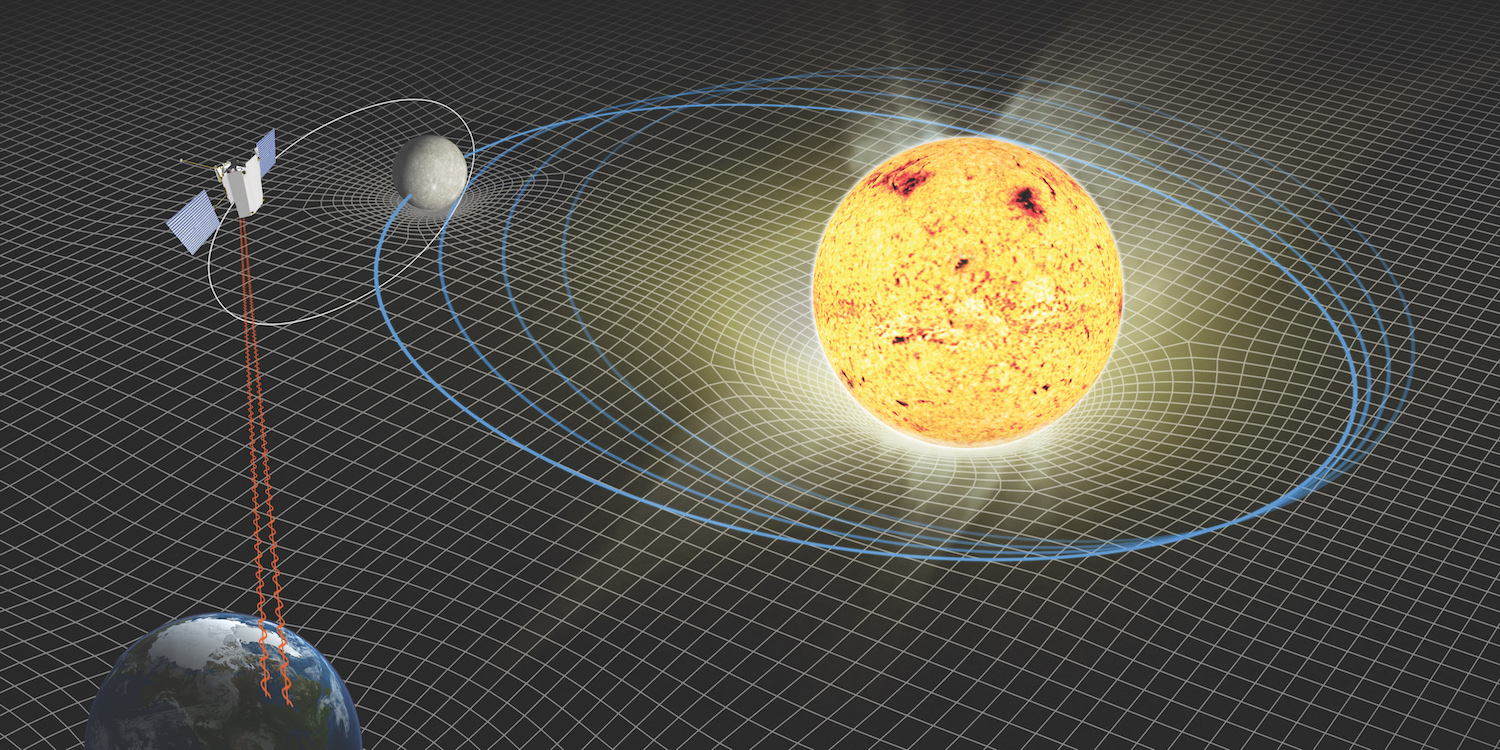Solar System Expansion and test of the Strong Equivalence Principle
Antonio GenovaThe NASA's Mercury
Surface, Space Environment, Geochemistry, and Ranging (MESSENGER) mission
represents a rare opportunity to simultaneously investigate theories of
gravitation, the geophysics of a terrestrial planet, and the evolution of the
Sun's interior. The spacecraft made three flybys of Mercury in 2008 and 2009
and orbited the planet from March 2011 through April 2015 [1]. The mission was
dedicated to the exploration of whole Mercury's environment from its deep
interior to the magnetosphere. However, the radio tracking data collected by
Earth's Deep Space Network (DSN) stations provide also crucial measurements of
the planet ephemeris. By analyzing subtle changes in Mercury's motion we
learned about the Sun and how its physical parameters influence the planet's
orbit. Mercury represents the perfect test object for these experiments because
it is so sensitive to the gravitational effect and activity of the Sun.
Mercury's role in testing theories of
gravitation has always been crucial because the strong gravitational mass of
the Sun creates notable perturbations on its orbit. For centuries, scientists
have studied Mercury's motion, paying particular attention to its perihelion,
or the closest point to the Sun during its orbit. Observations long ago
revealed that the perihelion shifts over time, called precession. Although the
gravitational tugs of other planets account for most of Mercury's precession,
they do not account for all of it.

Figure 1: NASA's MErcury Surface,
Space ENvironment, GEochemistry, and Ranging (MESSENGER) spacecraft traveled
more than six and a half years before it was inserted into orbit around Mercury
on March 18, 2011.
Credit: NASA/JHU APL/Carnegie Institution of Washington
The second
largest contribution comes from relativistic effects induced by the Sun, and,
in particular, from the Parameterized Post-Newtonian (PPN) coefficients γ and β. The precession of Mercury's perihelion first highlighted the
limits of Newtonian physics and later validated the predictions of Einstein's
theory of General Relativity (GR).
The Sun's
interior structure and dynamics also affect Mercury's ephemeris. The solar gravitational
oblateness  and the angular momentum
and the angular momentum  , which perturb the planet's orbit
through the gravitomagnetic Einstein-Lense-Thirring (ELT) effect. This
relativistic perturbation is related to the distortion of space-time induced by
the rotation of the Sun [2].
, which perturb the planet's orbit
through the gravitomagnetic Einstein-Lense-Thirring (ELT) effect. This
relativistic perturbation is related to the distortion of space-time induced by
the rotation of the Sun [2].
MESSENGER range
dataset represents also a great opportunity to test one of the foundations of
GR, the Strong Equivalence Principle (SEP). Einstein's theory of GR assumes the
validity of the equivalence principle that has been partially demonstrated by
laboratory experiments, to a precision of ~ 1 × 10-13 with recent
torsion-balance tests [3]. However, these precise results only concern the weak
equivalence principle, which is based on Galileo's postulate that different
objects fall with the same acceleration in a uniform gravitational field,
independent of their composition and structure. The SEP is an extension of this
concept and it states that a uniform gravitational field is locally
indistinguishable from an accelerated reference frame.
To measure this
effect, test-masses sufficiently large are required since they need to create a
self-gravitational force that is not negligible. For this reason, tests at the
scale of the solar system are suitable to prove the SEP. Our results confirm
that there are no violations of SEP with unprecedented accuracies. This study
represents the most accurate measurement of this relativistic effect, by
improving previous estimates based on Lunar Laser Ranging by a factor of 7 [4].
We were also able
to provide one of the first accurate experimental observations of the Sun's
mass loss rate. Previous estimates were mainly based on theoretical models that
show values of  ~ - 1 x 10-13 per year. Our estimate,
~ - 1 x 10-13 per year. Our estimate,  ~ - (6.13±1.47) x 10-14 per year, is 30% lower compared to predictions with
a significantly lower uncertainty [5]. Our mass loss rate estimate, in turn,
results in an improvement by an order of magnitude of the knowledge of the
temporal variation of the universal gravitational constant G, compared to previous work based on Lunar Laser Ranging data
analysis [6].
~ - (6.13±1.47) x 10-14 per year, is 30% lower compared to predictions with
a significantly lower uncertainty [5]. Our mass loss rate estimate, in turn,
results in an improvement by an order of magnitude of the knowledge of the
temporal variation of the universal gravitational constant G, compared to previous work based on Lunar Laser Ranging data
analysis [6].
These results
were retrieved with a novel technique of precise orbit determination that simultaneously estimated and integrated the orbits
of both MESSENGER and Mercury. This approach provides a comprehensive solution
that includes geophysical, heliophysics, and relativity results together with
their covariances. Previous studies were conducted as parallel and independent
investigations to exclusively determine either Mercury's geophysics or its
ephemeris. Our numerical integration of both orbits enabled us to reduce
significantly mismodeling of Mercury's trajectory that led previously to
imperfect geophysical solutions. Our reintegrated ephemeris for Mercury, which
is available below, shows lower errors compared to previous versions of the
NASA JPL DE430 and DE432 [7,8].

Figure 2: Schematic of experimental design. NASA and MIT
scientists analyzed subtle changes in Mercury's motion to learn about the Sun
and how its dynamics influence the planet's orbit. The position of Mercury over
time was determined from radio tracking data obtained while NASA's MESSENGER
mission was active.
Credit: NASA/GSFC
Data: Mercury Ephemeris
The integrated Mercury ephemeris derived from this study is available at various temporal resolutions.
For most users, the 60-min file will be sufficient and ideal (in terms of file size), but we provide the full (1-min) and higher (2-min and 5-min) versions as well.
These files contain the trajectory of Mercury with respect to the Sun between approximately 2008 JAN 07 and 2015 APR 22. See comments embedded within the BSP files for more details.
SPICE kernels: 1-min (~200MB) , 2-min (~100MB) , 5-min (~40MB) , 60-min (~4MB, recommended for most users).
Data Usage Policy
Antonio Genova, Erwan Mazarico, Sander Goossens, Frank G. Lemoine, Gregory A. Neumann, David E. Smith and Maria T. Zuber (2018), Solar system expansion and strong equivalence principle as seen by the NASA MESSENGER mission, Nature Communications, 9, 289, doi:10.1038/s41467-017-02558-1.
References
[1] MESSENGER website, http://messenger.jhuapl.edu.
[2] Iorio, L. Constraining the angular momentum of the Sun with planetary orbital motions and general relativity. Solar Physics 281(2), 815-826, doi: 10.1007/s11207-012-0086-6 (2012).
[3] Wagner, T. A., Schlamminger, S., Gundlach, J. H., and Adelberger, E. G. Torsion-balance tests of the weak equivalence principle. Classical and Quantum Gravity, 29(18), 184002, doi: 10.1088/0264-9381/29/18/184002 (2012).
[4] Williams, J. G., Turyshev, S. G., and Boggs, D. H. Lunar laser ranging tests of the equivalence principle. Classical and Quantum Gravity 29(18), 184004, doi: 10.1088/0264-9381/29/18/184004 (2012).
[5] Noerdlinger, P. D. Solar mass loss, the astronomical unit, and the scale of the solar system. Preprint at https://arxiv.org/pdf/0801.3807.pdf (2008).
[6] Müller, J., Hofmann, F., Fang, X., and Biskupek, L. Lunar Laser Ranging: recent results based on refined modelling. Earth on the Edge: Science for a Sustainable Planet, 139, 447-451, doi: 10.1007/978-3-642-37222-3_59 (2014).
[7] Folkner, W. M., Williams, J. G., Boggs, D. H., Park, R. S., and Kuchynka, P. The planetary and lunar ephemerides DE430 and DE431. Interplanet. Netw. Prog. Rep, 196, C1, Jet Propulsion Laboratory, Pasadena, CA, USA, URL: ftp://naif.jpl.nasa.gov/pub/naif/generic_kernels/spk/planets/de430_and_de431.pdf (2014).
[8] Folkner, W.M. Planetary ephemeris DE432. Technical Report. Jet Propulsion Laboratory, Pasadena, CA, USA, URL: https://naif.jpl.nasa.gov/pub/naif/generic_kernels/spk/planets/de432.pdf (2014).